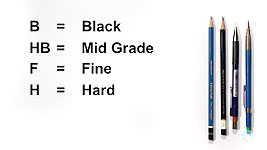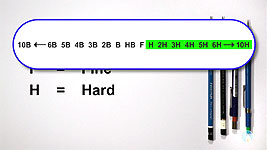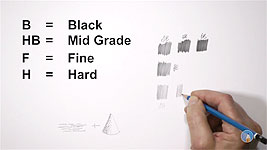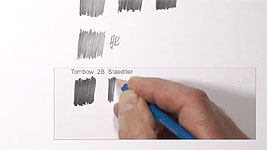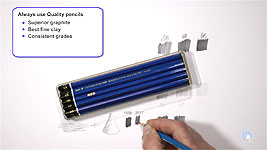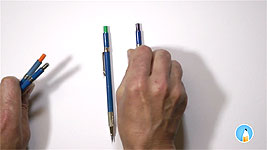Transcript
There are many different brands and types of pencil but they all contain the same grades of lead.
Grades? Well, yes -
grades describes the relative hardness from soft to hard, which is the same as saying from dark to light. There are 22 grades but most manufacturers make only 18 of them. And each grade has its own code, such as this Tombow, which is a 2B.
The grades are split into two groups:
B stand for Black
H stands for Hard
And in between those two is HB - a common writing or US #2 grade.
You might also come across the F grade.
F stands for Fine or Fine-point.
It's a writing grade, slightly harder than the HB so it sharpens to a finer point.
The two groups are numbered to describe their relative hardness or blackness.
The Blacks - the Bs - range from B to 10B. The higher the number, the softer the lead, and darker it will draw.
Hard - the Hs - range from H to 10H. The higher the number, the harder the lead and the lighter it will draw.
So, there's a Black range and a Hard range of grades - but how are the grades created? Well, leads are a mix of graphite - and graphite, incidentally, consists of flat plates, which is why it reflects light, unlike grainier charcoal that has very irregular grains. Mixed with the graphite is fine clay. The two are mixed together, finely ground, extruded, baked to fuse everything together, and finally dipped into hot wax or oil to make the application smoother.
Why add the clay? Well, pure graphite makes a black mark. The clay dilutes and lightens the marks, So, the more clay we add to the mix the harder and lighter is the result, which is the H grades. The more graphite and less clay, the softer and darker the lead becomes - they're the B grades.
As the number goes higher, the B grades become softer and therefore darker. The H grades become harder and progressively lighter. HB in the middle is, if you like, neither Hard nor Black; it's neutral; in the centre.
I must give you a warning! There is a hardness scale from 10B to 10H but the scale is relative and
each brand applies the scale to its own mix. One manufacturer's 2B or HB is not the same as another brand's 2B or HB. The Japanese, for instance, prefer a darker HB than the Europeans, and shifts their whole scale.
So, where Manufacturer #1 might divide their range from the darkest to lightest into 17 grades, another might do the same but produce more grades, such as Mitsubishi's Hi-Uni range that has 22 grades. For example, a Tombow 2B is darker than a Staedtler 2B.
I use Staedtler Lumograph, but whatever your choice, find your preferred brand and stick with it. Every time you pick up a pencil you need to know exactly how it will perform. If you don't, you'll be constantly re-learning, and that can be really frustrating. Pick your pencils; use just that brand; and you'll learn precisely what everyone of those grades does.
However, it's OK to use a different brand for a specific job. For instance, you might use your Tombow for producing your deep shadows. That's OK - but stick with that brand for that job.
Whichever brand, or mix of brands, you choose, always buy quality pencils.
- They will use the best quality graphite
- They will use the best fine clay. And they'll grind it for days, not hours, to remove all the scratchy impurities, Cheaper pencils will save money by reducing the grinding time or using inferior clays, so expect to find bits of grit in the mix. You do not want a pencil that is going to scratch your paper
- The grades will be consistent. These are Staedtler Lumograph from the later 1950's. This one was made this year. In over 60 years nothing has changed
- And quality pencils will have centred leads. Cheap pencils very often have off-centre leads and they will break constantly whenever they're sharpened. You might think it's a cheap pencil but it's false economy. Most of it is going to end up in your sharpener.
- Finally, use the best tools you can afford. You're and artist, a craftsman, so use a craftman's tools, even while you're learning. Don't consider using cheap pencils while you learn - you'll only have to learn all over again when you begin to use good pencils. Start with the best tools and produce the best results you can at that time.
Finally, now you've got your artists pencils, you need to develop a system for easy and quick recognition of the grades. Don't break your flow searching for your 4B. Know where it is instantly if you can. My Staedtler clutch pencils, for example, have colour-coded caps. I hold them in my free hand while I'm working and I can pull out any grade instantly.
This is the 2B.
This is the HB.
And this is the 8H.
© copyright: Mike Sibley 2018
